
MATERIALS SCIENCE-POLAND
Scope & Guideline
Exploring the Depths of Material Innovation
Introduction
Aims and Scopes
- Innovative Materials Development:
The journal emphasizes the synthesis and characterization of novel materials, including polymers, composites, ceramics, and metals, aimed at improving performance and sustainability. - Sustainable Engineering Practices:
A core focus is placed on sustainable materials and recycling, particularly the use of recycled materials and bio-based resources to enhance the environmental footprint of construction and manufacturing processes. - Nanotechnology Applications:
Research on nanostructured materials and their applications in various fields, including electronics, medicine, and catalysis, is a significant area of interest. - Mechanical and Physical Property Analysis:
The journal includes studies on the mechanical, thermal, and electrical properties of materials, often involving advanced characterization techniques and computational modeling. - Interdisciplinary Research:
There is a strong emphasis on interdisciplinary approaches that integrate materials science with fields such as biology, environmental science, and engineering to address complex challenges.
Trending and Emerging
- Biomaterials and Medical Applications:
Research related to biomaterials, particularly in the context of drug delivery, tissue engineering, and regenerative medicine, has surged, showcasing the integration of materials science with healthcare. - Green and Sustainable Materials:
There is a growing focus on the development of green materials, including bio-based composites and sustainable construction materials, driven by environmental concerns and regulatory pressures. - Advanced Coatings and Surface Treatments:
Innovative coatings and surface modification techniques are increasingly explored to enhance material properties, such as corrosion resistance, wear resistance, and biocompatibility. - Additive Manufacturing and 3D Printing:
The application of additive manufacturing techniques is on the rise, with research focusing on new materials and processes that enable complex geometries and customized solutions. - Nanomaterials and Nanocomposites:
The synthesis and application of nanomaterials and nanocomposites are trending, particularly in enhancing the mechanical, thermal, and electrical properties of traditional materials.
Declining or Waning
- Traditional Metallurgy:
Research focused solely on traditional metallurgy techniques and processes has seen a decline, as newer methodologies and materials, such as composites and nanomaterials, gain prominence. - Conventional Polymers:
Studies centered around conventional polymers without the incorporation of nanofillers or advanced processing techniques are less frequently published, indicating a trend towards more innovative polymer research. - Basic Material Characterization Techniques:
While foundational techniques remain important, there is a noticeable shift towards more advanced and specialized characterization methods, suggesting a waning interest in basic characterization approaches. - Static Mechanical Testing:
The focus on static mechanical testing alone is diminishing, with a growing trend towards dynamic, fatigue, and environmental testing to better understand material behavior under real-world conditions.
Similar Journals
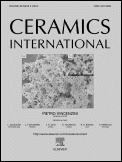
Ceramics International
Championing excellence in ceramic materials research.Ceramics International is a premier journal published by ELSEVIER SCI LTD, focusing on advancing the field of materials science with a specific emphasis on ceramics and composites. With an impressive impact factor and a top-tier standing in several critical categories, including Q1 rankings in Ceramics and Composites, Electronic, Optical and Magnetic Materials, and Materials Chemistry, this journal serves as a crucial resource for researchers and professionals alike. Established in 1981, it has consistently showcased cutting-edge research in various domains, including surfaces, coatings, and process chemistry technologies, making it invaluable for those advancing theoretical and practical knowledge in these areas. While access is through subscription, the journal’s rich content, profound insights, and rigorous peer-review process ensure high-quality articles that contribute meaningfully to the scientific community. By fostering innovation and collaboration through rigorous research, Ceramics International stands out as an authoritative source for those dedicated to the evolution of materials science.

Journal of Metals Materials and Minerals
Connecting Researchers in Metals and Materials EngineeringJournal of Metals Materials and Minerals (ISSN: 0857-6149) is a renowned academic publication dedicated to the interdisciplinary fields of metallurgical science, materials engineering, and mineralogy. Published by Chulalongkorn University, Metallurgy & Materials Science Research Institute in Thailand, this journal serves as a pivotal platform for researchers to disseminate their findings and explore innovative applications related to metals, ceramics, polymers, and biomaterials. Although the journal does not currently adopt an open-access model, it provides insightful content that facilitates knowledge sharing among professionals and academics alike. The journal has established its credibility with impressive Scopus ranking percentiles, particularly in categories such as Metals and Alloys and Ceramics and Composites. With an emphasis on advancing the understanding of materials science from 2017 to 2024, the Journal of Metals Materials and Minerals remains an essential resource for those striving to contribute to and stay informed about the latest trends and breakthroughs in these dynamic fields.

Composites Part C: Open Access
Unlocking Innovations in Ceramics and CompositesComposites Part C: Open Access, an esteemed journal published by Elsevier, is at the forefront of research in the fields of Ceramics and Composites, Mechanical Engineering, and Mechanics of Materials. Launched in 2020, this fully open-access journal facilitates unparalleled access to significant advancements in composite materials, ensuring that research findings are disseminated widely and freely throughout the global academic community. With an impressive Q1 ranking across multiple related categories and robust placements in Scopus rankings, specifically #78 in Mechanical Engineering and #24 in Materials Science, the journal serves as a vital platform for researchers, professionals, and students to publish their work and engage with cutting-edge studies. It aims to foster innovation and collaboration in the development and application of composite materials and their technologies, making it an indispensable resource for anyone invested in these dynamic fields.
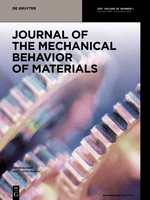
JOURNAL OF THE MECHANICAL BEHAVIOR OF MATERIALS
Innovating the Future of Materials ScienceJOURNAL OF THE MECHANICAL BEHAVIOR OF MATERIALS, published by DE GRUYTER POLAND SP Z O O, is a prominent open-access journal in the field of materials science and mechanics, dedicated to facilitating the dissemination of high-quality research findings since 2019. With an ISSN of 0334-8938 and an E-ISSN of 2191-0243, this journal provides a platform for researchers, professionals, and students to explore the mechanical behaviors of various materials, crucial for advancing engineering and scientific applications. The journal's impact is evidenced by its impressive rankings, including Q2 status in both Materials Science (miscellaneous) and Mechanics of Materials as of 2023. With a Scopus rank placing it in the top-half of indexed journals, the JOURNAL OF THE MECHANICAL BEHAVIOR OF MATERIALS is a vital resource for anyone looking to stay at the forefront of material behavior research. Based in Germany, it serves the global academic community while catering to the evolving needs of industry practitioners through its comprehensive open-access model.

Elastomers and Composites
Innovating Materials, Transforming IndustriesElastomers and Composites is a leading academic journal dedicated to the advancement of knowledge in the fields of polymer science and materials engineering, specifically focusing on elastomers and composite materials. Published by RUBBER SOC KOREA, this journal serves as a vital platform for researchers and professionals to disseminate innovative research findings and insights in material properties, applications, and synthesis techniques. Although it currently does not offer open access, the journal provides rigorous peer-reviewed content that enhances the global dialogue on elastomeric materials and their composites, reflecting its commitment to high-quality scholarship. With a strong emphasis on practical relevance and theoretical advancements, Elastomers and Composites aspires to reshape industry practices and academic thought, making it an invaluable resource for students, researchers, and practitioners alike. Positioned strategically within its field, this journal fosters collaboration and dialogue among scientific communities, all while supporting the growth of cutting-edge research programs worldwide.
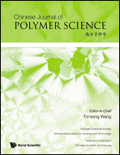
CHINESE JOURNAL OF POLYMER SCIENCE
Connecting Researchers to the World of Polymer ScienceThe CHINESE JOURNAL OF POLYMER SCIENCE, published by SPRINGER, stands as a premier periodical in the realm of polymer science, showcasing cutting-edge research and technological advancements since its inception in 1985. With an impressive impact factor reflecting its significance in the field, this journal is categorized in the top quartiles (Q1) of Chemical Engineering, Organic Chemistry, and Polymers and Plastics. It features a wide spectrum of innovative studies, thus serving as an essential resource for researchers, professionals, and students dedicated to understanding and advancing polymer-related technologies. The journal is indexed in Scopus, with notable rankings that highlight its influence in the disciplines of organic chemistry and materials science, making it a vital communication platform for authors around the globe aiming to disseminate impactful findings. Although not an open-access publication, the journal ensures robust accessibility through institutional subscriptions and partnerships, further emphasizing its commitment to the advancement of polymer science.

SOFT MATERIALS
Illuminating the Science Behind Soft MaterialsSOFT MATERIALS is a premier journal specializing in the dynamic and interdisciplinary fields of chemistry, condensed matter physics, and materials science. Published by Taylor & Francis Inc., the journal serves as a vital platform for researchers and professionals to disseminate their cutting-edge findings related to soft materials, which are pivotal to advancements in various applications such as nanotechnology, biotechnology, and polymers. With an ISSN of 1539-445X and an E-ISSN of 1539-4468, this journal has successfully built a reputation within the academic community since its inception in 2004. As of 2023, SOFT MATERIALS is ranked within the Q3 category in Chemistry (miscellaneous), Condensed Matter Physics, and Materials Science (miscellaneous), reflecting its growing influence as a respected source of scientific knowledge. Although it does not currently operate under an open access model, its substantial impact factor and Scopus rankings, which place it in the 39th to 45th percentile across pertinent categories, highlight its quality and significance in fostering research collaboration and discourse among scholars and practitioners worldwide. The journal's objectives include enhancing the understanding of the physical, chemical, and material properties of soft materials, making it an essential resource for students, researchers, and professionals passionate about materials innovation and development.
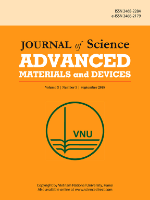
Journal of Science-Advanced Materials and Devices
Advancing Materials Science Through Open Access InnovationJournal of Science-Advanced Materials and Devices is a leading open-access journal published by Vietnam National University, dedicated to advancing the field of materials science through cutting-edge research and innovative developments. Since its inception in 2016, this journal has become a pivotal platform for sharing insights and discoveries in various subfields, including biomaterials, ceramics and composites, and electronic, optical, and magnetic materials. With impressive quartile rankings, including Q1 across multiple categories in 2023, and a notable Scopus ranking placing it in the top 15th percentile for ceramics and composites, it highlights the journal’s influence and prestige within the global academic community. Open Access since its launch, the journal aims to facilitate unrestricted dissemination of scholarly work, empowering researchers, professionals, and students to engage with the latest advancements. The Journal of Science-Advanced Materials and Devices is vital for those seeking high-quality contributions that influence both theoretical understanding and practical applications in the ever-evolving landscape of materials science.

Revue des Composites et des Materiaux Avances-Journal of Composite and Advanced Materials
Empowering Knowledge in the Realm of Advanced MaterialsRevue des Composites et des Materiaux Avances - Journal of Composite and Advanced Materials is a prominent academic journal published by the INT INFORMATION & ENGINEERING TECHNOLOGY ASSOC, based in France. With an ISSN of 1169-7954 and an E-ISSN of 1958-5799, this journal serves as a critical platform for the dissemination of innovative research in the field of composite and advanced materials. Currently categorized in the Q3 quartile of Materials Science and ranking 326 out of 463 in its category according to Scopus, the journal aims to bridge the gap between theoretical advancements and practical applications in material science. As it embraces an open-access model to increase accessibility, it caters to a diverse audience, including researchers, professionals, and students interested in cutting-edge materials technology. The journal covers a wide scope of topics ranging from manufacturing processes to material characterization, contributing significantly to the ongoing discourse in this evolving field. With convergence years extending from 2012 to 2024, it is poised to be an essential resource for anyone looking to stay abreast of the latest developments in composite science.
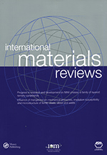
INTERNATIONAL MATERIALS REVIEWS
Pioneering Insights for Material Science ProfessionalsINTERNATIONAL MATERIALS REVIEWS, published by SAGE Publications Inc, is a leading journal dedicated to the comprehensive analysis of contemporary research in the fields of materials chemistry, mechanical engineering, mechanics of materials, and the study of metals and alloys. With an impressive impact factor and a Q1 ranking across multiple categories such as Materials Chemistry and Mechanical Engineering in 2023, it ranks amongst the top journals for innovative materials research. The journal has a long-standing history since its inception in 1987 and continues to serve as a crucial resource for academics and professionals alike. Although it is not open access, it is renowned for its rigorous peer-review process and its commitment to disseminating high-quality materials science research globally. Researchers, students, and industry professionals benefit greatly from the journal's insightful reviews, both for the advancement of theoretical knowledge and practical applications within the fast-evolving materials field.